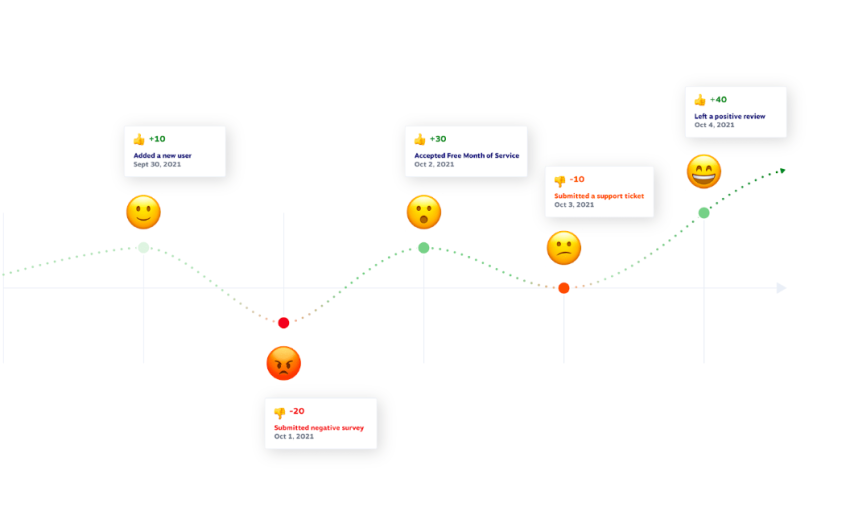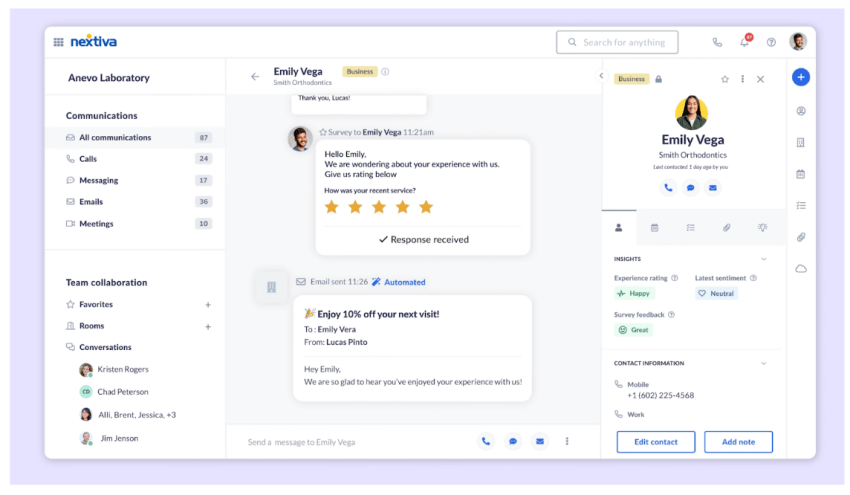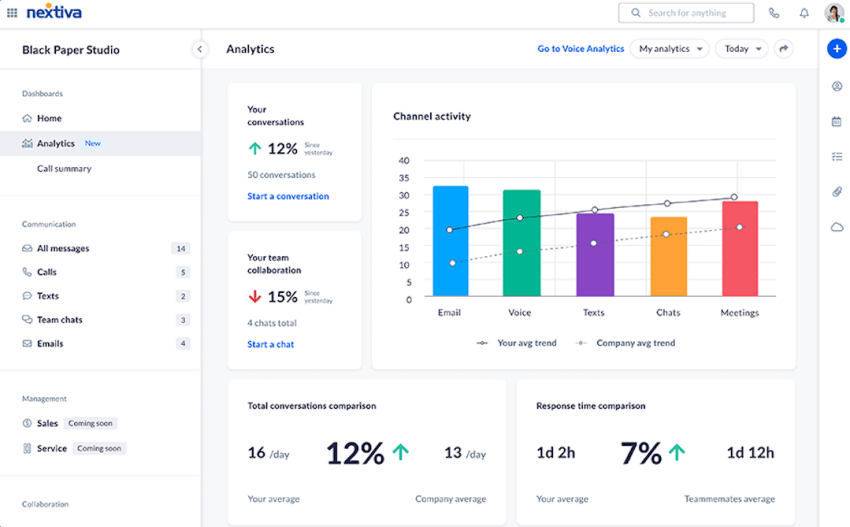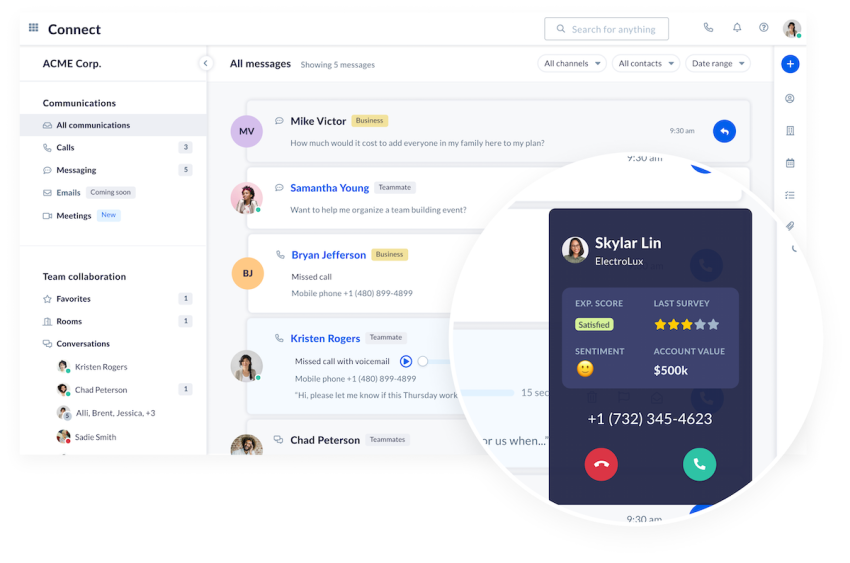Customer experience can make or break a business. Today’s educated customers aren’t just looking for a product or service; they’re seeking an experience that resonates with them emotionally.
To accomplish this, customer interactions — whether on social media, in physical stores, or on a support center call — must have positive customer sentiment. This positivity builds brand loyalty, which ultimately serves as a building block for a lasting customer relationship.
This is where Customer Experience Management, also known as CXM, enters the chat. CXM is the work of going the extra mile to understand your customers, anticipate their needs, and craft exceptional experiences that foster that necessary loyalty — and drive business growth.
In this guide, we’ll explore the benefits of customer experience management, discover strategies to refine your customer lifecycle, and learn about CXM software, which can help you chart a course for exceptional service.
Take the AI Maturity Assessment
In just 5 minutes, get your personalized score and recommendations to move forward with AI.
What Is Customer Experience Management?
Customer Experience Management, or CXM, is the process of optimizing every customer touchpoint to create a positive and consistent experience for the customer.
This process tracks and organizes customer interactions across the company so that a team of specialists can optimize those interactions over time.
Successful customer experience management will provide a complete map of your customer’s journey with you from their first visit to your website to their post-purchase survey. It will allow you to get to know your customers inside and out, predict their needs, and tailor their experiences to meet or exceed their expectations.
Think of customer experience management as an orchestra; you, the business owner, are the conductor. Each part of the orchestra represents a different department: marketing, sales, product development, or customer support. You must make these elements work in harmony to deliver a great experience.

Why Is Investing in CXM Important?
Customer experience isn’t just a differentiator — it’s the foundation of sustainable growth. Each customer interaction presents a valuable opportunity to gather insights, identify patterns, and capture the Voice of the Customer (VoC). By leveraging this information, businesses can continuously refine their marketing strategies, enhance customer advocacy, and ultimately elevate the overall customer journey. And the rewards are substantial.
Consulting firm McKinsey reports that their customer experience strategy has led them to impressive results over the past decade, including increases in sales by up to 20%, decreases in service costs of up to 50%, and increases in customer satisfaction of up to 20% for over 900 of their clients.
The reason CXM is so powerful is simple: customers crave connection and understanding.
CXM fundamentally shifts the focus from simply selling to building genuine, human-centered relationships. By prioritizing customer needs and anticipating their challenges, businesses create a sense of trust and loyalty that transcends the transaction.
The Difference Between CXM and Customer Relationship Management (CRM)
While sometimes used interchangeably, customer experience management (CXM) and customer relationship management (CRM) systems serve distinct yet complementary purposes. Understanding their differences is crucial for creating a comprehensive customer-centric strategy.
Your CXM strategy is designed to shape the customer’s perception of your brand across every touchpoint. The goal is to create positive, memorable, and consistent interactions that foster loyalty and advocacy.
Your CRM strategy is designed to organize and manage customer interactions. The goal is to build and maintain profitable relationships, streamline sales and marketing processes, and maximize customer lifetime value.
Think of your CRM as the empty house your customer is moving into. The walls are white and blank, but it’s a roof over their head. It does the job, but not much else.
When you implement a CXM strategy, you transform those boring white walls. Now, that house shines with bright colors, beautiful paintings, and maybe even a rug on the living room floor. The customer reclines on a custom couch and sips hot cocoa in front of your metaphorical fireplace.
In the simplest terms possible, where your CRM ends, your CXM begins.
Benefits of Customer Experience Management
When implemented, a CXM strategy doesn’t just translate into good vibes — it directly benefits your business in concrete ways.
Here are just a few of the most common ways a strong CXM strategy can tangibly benefit your brand.
1. Achieve a stronger product–market fit
An effective customer experience management strategy is like a compass that guides you through the needs of your existing and new customers. By staying in constant contact with them, you gain more opportunities to promote greater customer advocacy.
This helps you anticipate and exceed expectations, crafting offerings perfectly suited to each customer profile.
2. Improve your employee experience
Customers aren’t the only ones benefiting from unified CXM — employees do, too. Having more positive customer experiences means dealing with fewer angry ones, resulting in more enjoyable employee interactions.
A happier workforce leads to more trust, engagement, and productivity at work.
3. Reduce churn
Effective management reduces customer churn by cultivating deeper relationships between customers and your brand.
A business that consistently meets or exceeds customer expectations knows how to foster customer trust, making it much less likely that customers will turn to your competitors.
These days, the stakes are high. A single negative customer experience can significantly affect brand loyalty: 32% of customers would consider switching companies after only one poor experience, reports PwC, and 16% would even pay more for higher quality service.
At the heart of reducing churn lies empathy.
Customer experience best practices, personalized experiences, simple onboarding, and proactive problem-solving create caring connections with your existing customers and help ease their pain points.
Good customer experience management stabilizes your customer base and ensures long-term profitability.
4. Create more profitable customer segments
Focusing on customer experience management initiatives can help you identify and cultivate more profitable customer segments.
By studying these segments, identifying patterns, reviewing customer interactions, and analyzing feedback, companies can establish which segments are more engaged and assign these a higher lifetime value.
With the right customer experience management platform, companies can tailor their offerings based on qualitative customer data, ultimately boosting their bottom line.
By knowing and providing your customers with exactly what they need, they’ll become brand advocates, sharing word-of-mouth reviews and driving further business growth on your behalf.

5. Increase operational efficiency
The impact of CXM on operations is often overlooked.
Key customer insights can identify redundant processes and help you shape more efficient customer operations. This measure is about cutting costs and creating an agile company that responds well to customer needs.
Above all, customer experience management helps your entire team meaningfully increase customer loyalty as a routine business function — not merely a one-off effort to grow NPS survey responses.
✨ New Data: 2025 State of CX: Insights & Strategies for Success
How to Build a Seamless Customer Journey
A seamless customer journey aims to guide customers effortlessly through their interactions with your brand, leaving them feeling valued and understood.
Let’s look at the four steps to creating that perfect customer journey.
🌐 Step 1: Optimize omnichannel experiences
Objective: Deliver a consistent experience across all channels
Modern customers often switch between devices, platforms, channels, and physical stores, making it important to deliver consistent service. This ensures customers receive the same level of attention no matter how they choose to engage with your business. It also creates a rare atmosphere of consistent customer support.
Unfortunately, ensuring this consistency is often easier said than done.
By integrating your communication channels and your customer data into a central system, you’ll be able to deliver and manage seamless service across all touchpoints. By integrating your communication channels and your customer data into a central system, you’ll be able to deliver and manage seamless service across all touchpoints.
📌 Step 2: Proactively address at-risk customers
Objective: Identify early indications of churn
The familiar saying holds, confirms Gartner: It’s far more cost-effective and profitable to retain and sell to an existing customer than to acquire a new one.
That’s why proactively identifying and engaging with at-risk customers is a strong strategy for minimizing churn. To minimize churn, you need to monitor customer behavior and feedback to identify early signs of dissatisfaction.
Then, you can take preemptive action by reaching out with personalized digital experiences or solutions, automating the deployment of special offers, or simply reminding them that you value their business.Then, you can take preemptive action by reaching out with personalized digital experiences or solutions, automating the deployment of special offers, or simply reminding them that you value their business.
📝 Step 3: Streamline onboarding steps
Objective: Provide numerous check-ins and opportunities for feedback
Customers appreciate simple processes, and if your onboarding demands too much of them, you’re off to a bad start. Simplifying the onboarding process is key for maintaining customer interest and lays a strong foundation for a long-term relationship.
This could look like:
- Providing simple information and instructions
- Guiding customers through the first steps
- Setting clear expectations and being transparent
It’s also best practice to check in often during this process, allowing customers to provide feedback. It’s rarely too early to ask them what they think.
❌ Don’t box knowledge in
Objective: Share insights openly with team members
Encourage the sharing of insights within and across teams for the most cohesive customer-centric experience. Cloud-based, self-service CXM software can help companies avoid detrimental data silos.
You never know how other colleagues or teams may benefit from customer data, and collaborating enhances the customer experience.
According to Treasure Data, access to customer experience insights remains a challenging factor for 54% of organizations.
High-quality customer service starts with well-informed, unified teams that frequently share insights.
Nurture a culture of knowledge sharing with regular data training sessions and team meetings and make centralized pools of customer feedback and insights easy for everyone on the team to access, not just data ops individuals.
| Optimizing the Customer Journey | ||
| Old CX | Improved CX | |
| Optimize omnichannel experiences | The customer has to call separate numbers for billing and technical support, repeating their issue multiple times. | The customer starts with an online chat and seamlessly transitions to a phone call with an agent who already has their information. |
| Proactively address at-risk customers | Customer abandons their online shopping cart; the company does nothing. | Customer abandons their cart; the company sends a personalized email with a discount code and helpful product suggestions. |
| Streamline onboarding steps | New customers struggle to navigate a complex website with no clear instructions. | New customers are guided through a simple setup process with helpful tooltips and a welcome video. |
| Encourage knowledge sharing | Support agent gives incorrect information because they weren’t aware of a recent product update. | All agents can access a centralized knowledge base with the latest product information. |
The Most Important Features in CXM Tools
Harnessing the power of data is crucial for CXM success, so look for these essential features when selecting your customer experience management tool.
1) CRM integration
A customer relationship management platform stores customer information, tracks interactions, and helps businesses create stronger connections.
It plays a large part in CXM, and having a CRM integrated with your systems makes it easier for your teams to work together, deliver excellent support experiences, and put the customer first.
Key benefits of CRM integration:
- Sync all customer data into a single, unified system
- Access a comprehensive view of customer interactions and history
- Enhance personalized service and informed decision-making
- Provide workflow and marketing automation capabilities

Nextiva’s Salesforce integration, for example, bridges the information gap between your CRM and phone system. This handy integration helps your team access additional features, such as real-time call logging within Salesforce to store notes on a call and automatically log activity in Salesforce.
A feature like this further enriches your customer data and the potential CXM insights drawn during analysis.
2) Customer journey mapping
Customers pass through multiple stages as they interact with your brand. A customer journey map visualizes this path from start to finish.
Each map is made of touchpoints that include interactions such as discovering your product on Instagram or reaching out for technical support. Each interaction serves as an opportunity for you to delight customers while collecting valuable data.

A clear map of your customers’ journeys allows you to identify and track key touchpoints, such as trial signups or predicted outcomes.
It’s a vital component of customer experience management, and Gartner outlines it as a key factor for customer success. Of marketers polled, 47% said journey maps positively impact the success of their CXM efforts.
Key benefits of customer journey mapping:
- Model customer journeys with your brand from start to finish
- Observe the sales experiences from your customer’s perspective rather than the sales perspective
- Identify key touchpoints and milestones
- Predict how customers will behave as they travel through your sales funnel
Here’s an example that begins with a visit to your website:
Your customer visits a landing page, signs up for your newsletter, and begins a chat with your support agent. Several days later, the customer receives your newsletter, which leads to a demo booking and, eventually, a purchase.

3) Omnichannel customer engagement
Opting for a platform that embraces omnichannel customer engagement results in a unified experience across all platforms. This seamless experience thrills customers, who often interact with brands across three to five communication channels.
Benefits of omnichannel customer engagement:
- Captures customer experiences across channels (online, in-store, and on mobile)
- Helps maintain a cohesive and consistent brand experience
- Ensures a smooth customer journey
- Leads to high customer retention and brand loyalty
- Gains better customer insights
Effective omnichannel engagement strategies in action include consistent messaging, omnichannel staff training, and proactive support quality across all channels.
For a retail brand with a website and mobile app, effective omnichannel engagement could mean syncing a customer’s shopping cart across devices or ensuring that a contact center agent is already informed about an issue a customer raised on social media.

For modern customers, it’s all about providing a seamless experience where the customer picks up exactly where they left off.
4) Enterprise analytics
Enterprise analytics go beyond traditional data analysis by incorporating elements such as AI. Thanks to advanced features, businesses can forecast customer behavior and build more accurate customer journey maps.
Benefits of enterprise analytics:
- Capture data about customer profiles, personas, and behaviors
- Produce sophisticated, easy-to-read visualizations for informed decision-making
- Predict outcomes, allowing you to anticipate customer behaviors
- Provide real-time metrics that are easily shared with your team
- Highlight customer behavior, preferences, and trends, aiding in strategic decision-making and targeted marketing efforts

A fast-food franchise, for example, can leverage predictive enterprise analytics for CXM by forecasting regional ordering trends. This helps teams create tailored menus, efficient supply chains, and strategic outlet placements.
The result? Customer needs and preferences are proactively being met.
5) Call Pop
Call Pop, also known as a screen pop, is a handy feature for customer service operations. The service experience significantly improves when agents have comprehensive customer information during calls.
Benefits of Call Pop:
- Provides contact center call agents with customer information for every incoming call, such as contact information, company, payment details, customer history, and customer sentiment
- Reduces abandonment rates and average handle call time
- Improves sales conversions with relevant sales offers
Call Pop enables call center agents to answer every call with valuable customer context. Useful features include displaying the account value, a last interaction indicator (i.e., positive or negative), and an experience score.

These data points help call agents deliver remarkable customer service experiences with personalized conversations. With each call, they save time, build trust, and gain deeper insights.
Elevate Your Customer Experience With Nextiva
Effective customer experience management is a pivotal element of business that small business owners cannot ignore. Knowing your customers’ needs and having a deeper understanding of their pain points leads to loyal customers.
Customer experience management provides business owners with a roadmap to delivering an unforgettable experience that makes customers feel understood and keeps them returning for more.
The key to success with your customers and CXM lies in choosing the right tools that provide omnichannel experiences, accurate customer journey mapping, and insightful analytics.
Nextiva’s unified CXM platform empowers leaders to do just that. By offering unified customer data in an omnichannel environment, your customer experience will be unmatched in the marketplace.
Discover how to create the ultimate customer journey with Nextiva today.
Is your CX falling short?
Assess and elevate your strategy with the Gartner® CX Maturity Model report.

Customer Experience Management FAQs
Given the dynamic nature of startups, communication tools that are cost-effective, scalable, and easy to use are best suited for these types of companies. Many startups choose software that streamlines communication (phone, video conferencing, team chat, file sharing, etc.) and reduces costs.
Tools such as Slack, Zoom, and Nextiva are popular choices for startups. When choosing the best communication tool for your business, consider your industry, the size of your team, your communication needs, and the platform’s flexibility.
Enterprises require robust communication providers that prioritize their extensive security and privacy needs. Ideally, these tools should easily integrate into their existing IT infrastructure and support a large number of users. Microsoft Teams, Cisco Webex, Nextiva, and Slack are popular enterprise options.
Choosing the best communication platform for an enterprise requires a thorough assessment of its security and privacy needs, communication channels, IT infrastructure, and budget.
Businesses can simplify their internal and external communications by adopting tools that consolidate their communication channels into a single system. A unified communication platform such as Nextiva combines phone, video conferencing, team messaging, call center, and social media management into a secure, easy-to-use, cloud-based tool.
With the rise of remote work models, businesses should adopt clear communication policies, provide training, and utilize asynchronous strategies to maximize the effectiveness of their teams.
CXM is the overarching strategy of managing all customer interactions to create a positive experience. VoC, on the other hand, is a specific component of CXM that focuses on gathering customer feedback. CXM managers, for example, would use VoC data to improve the overall customer journey.
CX encompasses the customer’s entire journey with a brand, including all touchpoints and interactions. User experience, or UX, on the other hand, focuses specifically on the usability and experience of a product or service—often the website or platform. UX is part of CX, but not all of it.
A customer experience manager is responsible for designing, implementing, and overseeing a company’s CXM strategy. They act as the customer’s number one advocate within the company, ensuring every touchpoint delivers a positive and consistent experience.
The 5 C’s of customer experience are Clarity, Consistency, Convenience, Completeness, and Creativity. Together, these elements form a framework for building exceptional customer journeys.

















 Customer Experience
Customer Experience 
















